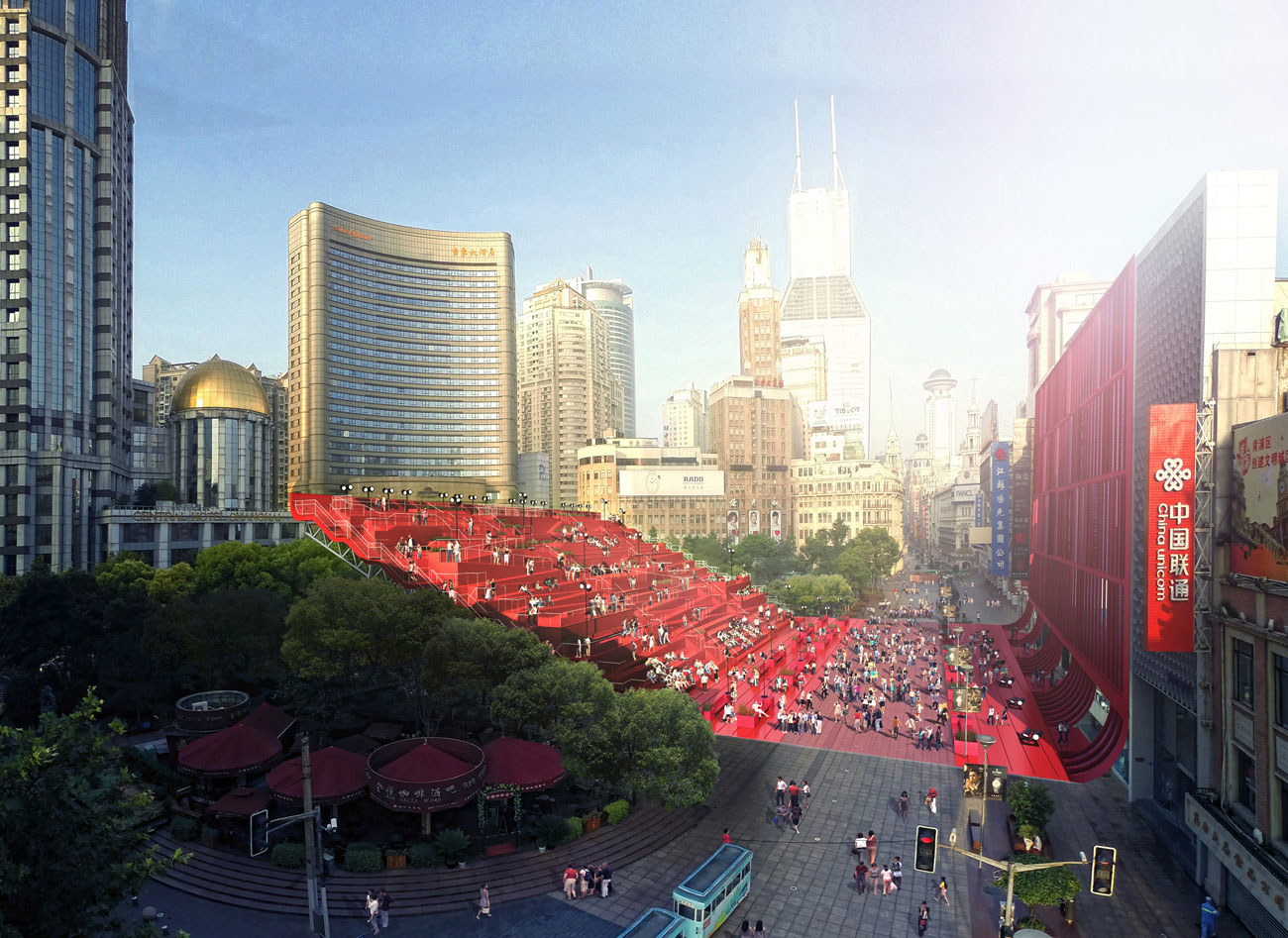
© 100architects
Red Carpet
Shanghai, China | East Nanjing Road
This project is located in Shanghai, on East Nanjing road’s Century Square, the most famous and glamorous pedestrian street in the “heart” of the city center.
The essence of this street is its commercial status, which was historically developed as a link between East and West, connecting directly the port with the city, therefore used as the principal trading platform, becoming a cultural and social active axis.
These features and its consequences on space have remained till now, being today the commercial street in Shanghai per excellence, constantly receiving thousands of pedestrians, locals and tourists, enjoying the existing multicultural mixture and its commercial stores. Currently, the Century Square is a flat car-free open area that also contains a small performance stage rarely used during most of the year.
It is the only area with this condition in the whole east Nanjing road but it lacks of an attractor, a landmark for its urban scape.
The design strategy is to create a massive inclined plaza as a grandstand that overlooks toward the pedestrian road, generating unique urban views of Shanghai downtown. Also, the “red” layer reaches the road to then climb up the existing buildings as a curtain façade for public art, projections and performances.
This produces a very intense segment in the pedestrian Nanjing road. The object’s shape contains the space adding new properties transforming this segment of East Nanjing in a highly stimulating space.
The Red Carpet is an open amphitheater, where the show is massified, inviting passersby to enjoy vibrant shows in a surreal atmosphere of design, jewelry and glamour.
The aesthetics of the project resembles a red carpet of giant proportions, folding from the storefronts of the building at the north, top to bottom generating a cavity in the same commercial axis.
The covered space on the south, under the seats structure, has two different uses. A more exposed area in direct contact with the passersby, works as an open market using the structure itself as sunshade protection. While the inner area under the structure is used as a small bar, with public toilets and others amenities.
The structure is made of metal trusses that generate the support for the precast concrete blocks that builds the horizontal seating. While the remaining elements are built on red wood and red metal panels.
In the front part, the vertical metal structure is covering the buildings with perforated metal panels allowing plenty of light and air flows from the exterior, which enables to gain this massive surface for public amusements, projections and background for performances.
Credits
PROJECT NAME: Red Carpet
DESIGN: 100 Architects (Shanghai)
DESIGN TEAM: Marcial Jesús, Madalena Sales, Pablo Juica
CLIENT: Undisclosed
SIZE: 12,080 m2
STATUS: Unbuilt
LOCATION: Shanghai, East Nanjing Road (China)
About
Grounded Object in Shanghai
The object’s shape contains the space adding new properties; a highly stimulating space exposed to a massive inclined plaza towards Nanjing road.
To know more click above!
More images
What is a neighborhood intervention?
This is the medium-scale type of intervention that takes place in the public realm of a city, related to the altering of a portion of a neighborhood. A type of intervention of such magnitude and notoriety impacts not only the immediate surrounding urban environment but rather the urban dynamics of a whole neighborhood, becoming an urban landmark and a local attractor of social interactions in a given neighborhood.
The main objective of this typology is to trigger massive public interest in the place through a strong visual impact and injection of activities, encouraging the increase of high public influx and establishing an urban landmark that can cultivate important human dynamics and boost commercial activity. These phenomena are achieved through the creation of spaces for leisure, entertainment, play and collective joy, catalyzing important social interactions throughout the neighborhood.
This topology of intervention, normally is used by real state developers to bring fresh and unique ideas to the public realm of their urban developments, which contributes to stand out in the market, establishing a distinct brand identity through innovative, and user-oriented design solutions that enhance the quality of life and thus, the appeal and value in the eyes of potential buyers or tenants, increasing the marketability of the project and potentially leading to higher property values, rental rates and ultimately faster sell out. This interventions maximize the value of the entire neighborhood.
Projects
insta100
Publications